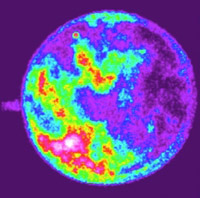Researchers at the Georgia Institute of Technology have developed a liquid rocket engine simulator and imaging techniques that can help explain the cause of explosive sound waves in rocket engines.
It is believed that such waves are created by energy supplied by the combustion process and that they have been responsible for many catastrophic rocket failures.
The Georgia Tech research team was able to clearly demonstrate that the phenomenon manifests itself in the form of spinning acoustic waves that gain destructive power as they rotate around the rocket’s combustion chamber.
'This is a very troublesome phenomenon in rockets,' said Ben Zinn, the David S. Lewis Jr. Chair and Regents’ Professor in the Guggenheim School of Aerospace Engineering at Georgia Tech. 'These spinning acoustic oscillations destroy engines without anyone fully understanding how these waves are formed. Visualising this phenomenon brings us a step closer to understanding it.'
During past investigations into this damaging instability, scientists were able to observe initial stages of the problem but were forced to shut down engines before the waves could fully develop and cause serious damage to the engine. Researchers were also hindered by their inability to clearly observe the complex processes inside the investigated rocket engines.
But with help from Dr Oleksandr Bibik, a visiting physicist and research scientist from Ukraine, the Georgia Tech research team developed an experimental setup and imaging technique that provides detailed information on how the waves form and behave.
First, the researchers developed a low-pressure combustor that served as a true simulator of larger rocket engines. Bibik then used a very-high-speed camera in combination with series of fibre optic probes that together allowed researchers to clearly observe the formation and behaviour of excited spinning sound waves within the engine. Additionally, Bibik’s new imaging method enabled researchers to determine the conditions under which these waves are excited and how they can be controlled.
Bibik’s high-speed camera views the reaction zone through a system of filters that allow only specific light radiation generated in the combustion zone to reach the camera’s lens. This strategy eliminates all background light interference and provides clear images of combustion (and sound) waves spinning around the engine’s periphery. Simultaneously, strategically placed fibre optic probes collect information on the reaction process oscillations in various locations in the combustor.
Using these new techniques, the research team discovered that the destructive waves gained energy as they spun around the engine’s periphery at a rate of 5,000 revolutions per second.
The capability to simulate and observe these destructive oscillations in a controlled laboratory environment could help researchers develop techniques to prevent their occurrence in real engines.
'Better understanding this phenomenon could very likely lead to safer tactical and space missions and save billions of dollars for technologies that use combustors,' Zinn said.

Very high speed acoustic waves building inside a small, simulated rocket combustor




Glasgow trial explores AR cues for autonomous road safety
They've ploughed into a few vulnerable road users in the past. Making that less likely will make it spectacularly easy to stop the traffic for...